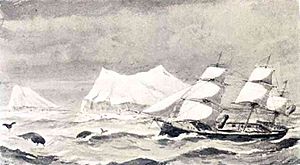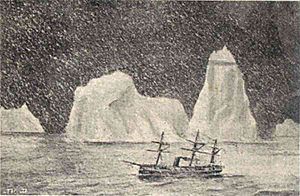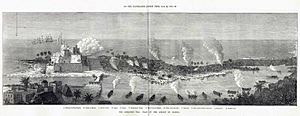HMS Druid (1869) facts for kids

The Druid amongst icebergs in the Straits of Belleisle
|
|
Quick facts for kids History |
|
|---|---|
| Name | HMS Druid |
| Builder | Deptford Dockyard |
| Laid down | 1868 |
| Launched | 13 March 1869 |
| Completed | February 1872 |
| Fate | Sold for scrap, 10 November 1886 |
| General characteristics (as built) | |
| Class and type | Briton-class wooden screw corvette |
| Displacement | 1,791 long tons (1,820 t) |
| Tons burthen | 1,322 bm |
| Length | 220 ft (67.1 m) (p/p) |
| Beam | 36 ft (11.0 m) |
| Draught | 16 ft 6 in (5.0 m) |
| Depth of hold | 21 ft 6 in (6.6 m) |
| Installed power | 2,272 ihp (1,694 kW) |
| Propulsion |
|
| Sail plan | Ship rig |
| Speed | 13 knots (24 km/h; 15 mph) |
| Complement | 220 |
| Armament |
|
HMS Druid was a wooden warship called a Briton-class. She was built for the Royal Navy (the British navy) in the late 1860s. The Druid spent her time serving far from home in places like the Cape of Good Hope and North America. She was eventually sold for scrap in 1886.
Contents
Building the HMS Druid
The Druid was a pretty big ship for her time. She was about 220 feet (67.1 m) long and 36 feet (11.0 m) wide. When fully loaded, she weighed around 1,791 long tons (1,820 t). Her crew included 220 officers and sailors.
Engines and Speed
The ship had a powerful two-cylinder steam engine built by Maudslay, Sons and Field. This engine turned a single propeller, which was about 15-foot (4.6 m) wide. Four large boilers created the steam needed to power the engine. This gave the Druid a top speed of about 13 knots (24 km/h; 15 mph) (knots) during her sea trials. She could carry 285 long tons (290 t) of coal to fuel her engine.
Sails and Steering
Even though she had a steam engine, the Druid also had a full set of sails, covering an area of 15,000 square feet (1,394 m2). Her main masts were made of strong iron, while the other masts were wood. However, she wasn't very good at sailing. Her fastest speed using only sails was about 11 knots (20 km/h; 13 mph). This was partly because her propeller couldn't be lifted out of the water or folded, which created drag. Also, the propeller made it harder to steer the ship when only using sails. After her first time in service, her sails were changed to a barque style.
Weapons
The Druid was armed with different types of rifled muzzle-loading guns. She had two large 7-inch (178 mm) guns, one at the front (on the forecastle) and one at the back (on the poop). These were used as chase guns, meaning they could fire straight ahead or behind the ship. She also had eight 6.3-inch (160 mm) guns mounted along her sides, which could fire to the left or right. Later, these guns were replaced with fourteen lighter 6.3-inch (160 mm) guns, with two of them still serving as chase guns.
Life and Service of the HMS Druid

The building of the Druid began in 1868. She was officially launched on 13 March 1869, with important guests like Princess Louise and Prince Arthur watching. She was finished in February 1872 and was the very last ship ever built at the Deptford Dockyard.
Overseas Missions
The Druid was first sent to the Cape of Good Hope Station, which was a naval base near South Africa. She stayed there for two years under the command of Captain Maurice Nelson. After that, she was moved to the North America and West Indies Station, serving in the waters around North America and the Caribbean.
Returning Home
In December 1876, the Druid returned home to Britain. She was then refitted, which included getting her new set of guns. She started service again in February 1879 and went back to the North American Station. Finally, she came home in September 1882 and was paid off, meaning her crew was sent home and the ship was taken out of active service. The Druid was kept in the Medway river until she was sold for scrap on 10 November 1886.


